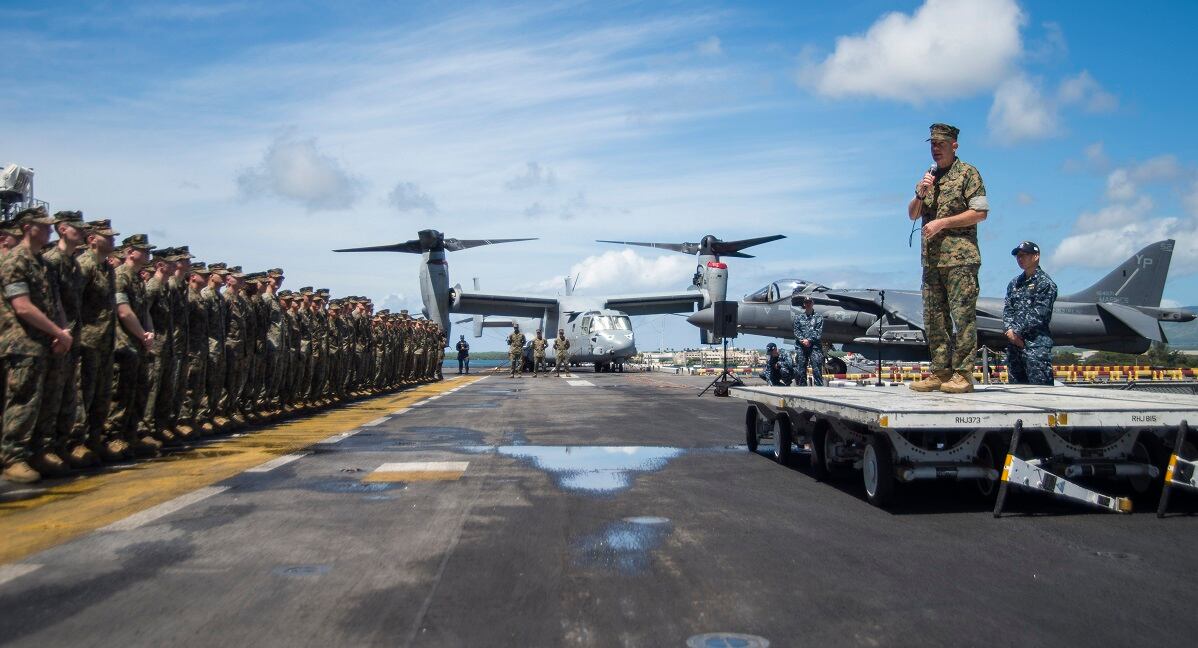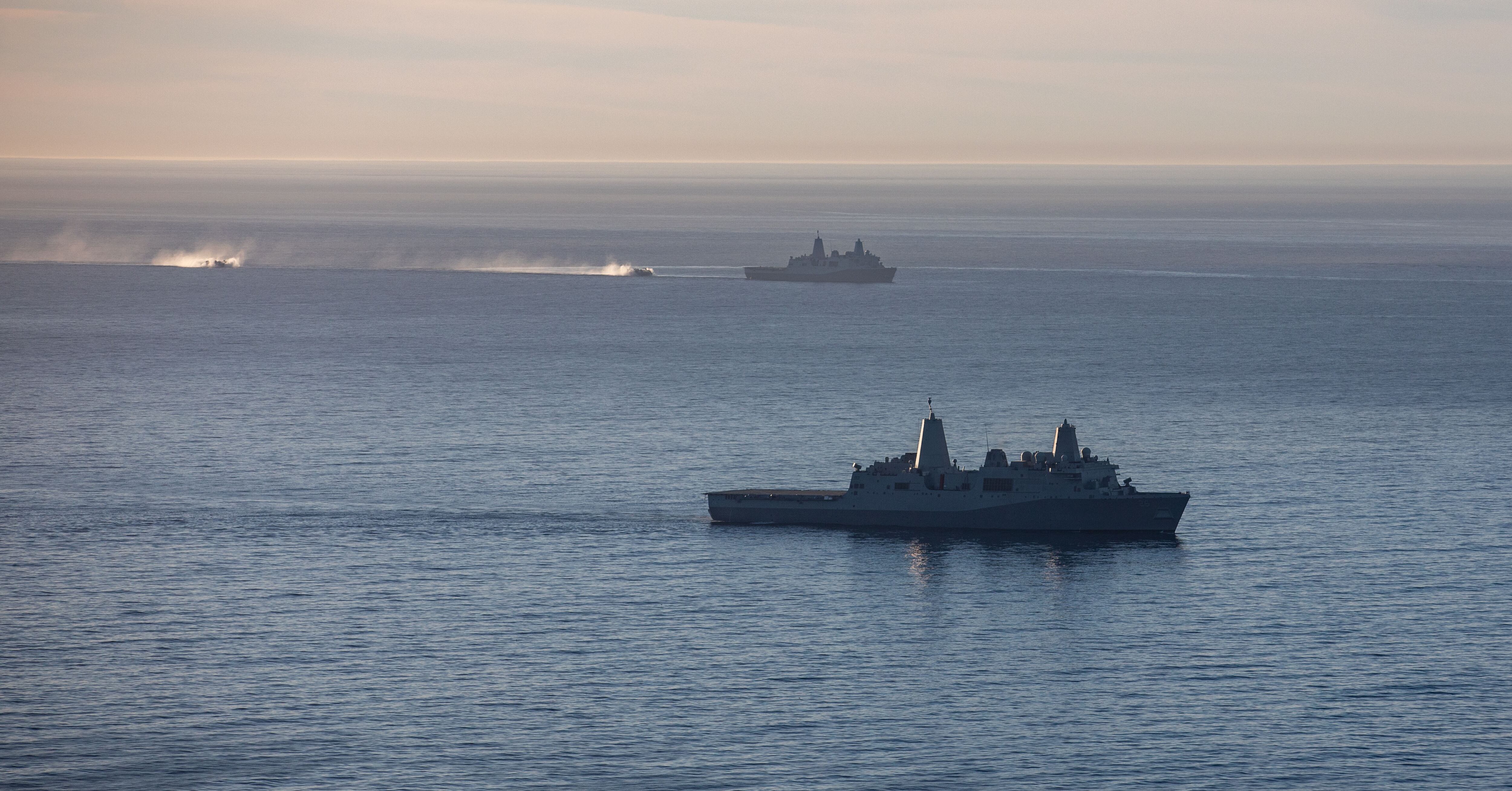Correction: CAPE and Under Secretary of the Navy Erik Raven met with the Office of Management and Budget to help inform Deputy Defense Secretary Kathleen Hicks’ decision on a way forward from the disagreement described in this story.
WASHINGTON — The White House was called in to help settle a disagreement between the Department of the Navy and the Department of Defense regarding an amphibious warship requirements study owed to Congress, a defense official told Defense News.
The Navy and Marine Corps told lawmakers this spring they were nearing the release of a study looking at the number and types of amphibious ships needed to fulfill operational requirements. Even Defense Secretary Lloyd Austin told the Senate during an April 7 hearing that the study would be “forthcoming in the next several weeks.” It was originally set to be completed in March.
However, on Nov. 15, Sens. Tim Kaine and Roger Wicker sent a letter to Navy Secretary Carlos Del Toro, asking why they had not yet received the study some seven months after that testimony.
Navy spokeswoman Lt. Gabrielle Dimaapi told Defense News the service did not yet send the study to Capitol Hill because stakeholders at the Office of the Secretary of Defense level were reviewing it.
“The Department of the Navy’s internal study on amphibious requirements is undergoing full coordination within the Department of Defense and across the interagency. The military departments coordinate closely with these stakeholders to ensure our requirements are in alignment with the overarching National Security Strategy,” she said.
Furthermore, she added, the Department of the Navy was working with the Office of the Secretary of Defense and its Cost Assessment and Program Evaluation office, as well as the White House’s Office of Management and Budget to “quickly and fully coordinate this report” and provide it to lawmakers before the next Congress is seated at the beginning of January.
Defense News asked CAPE what accounted for the monthslong gap between the Navy completing its version of the study and now, with the coordination effort ongoing. CAPE did not provide any comment.
The disagreement
A defense official, who was not allowed to speak on the record about this issue, described to Defense News a standoff between the Department of the Navy and the Pentagon over this report.
In line with standard practice, the Navy submitted its amphibious requirements study to CAPE, the deputy defense secretary and other stakeholders. The official said that, at some point in the process, CAPE asked the Navy to reconsider certain portions of the study or its results. The Navy declined to do so, standing by its original study. With the Navy declining to revise its report and CAPE declining to approve it and pass it along to Congress, the report sat at the Pentagon.
The official said CAPE and Under Secretary of the Navy Erik Raven met with OMB the week after Thanksgiving to help inform Deputy Defense Secretary Kathleen Hicks‘ decision on a way forward from this disagreement, whether that meant sending the report as-is to Congress or asking the Navy again to revise it.
Defense News reached out to Hicks’ office for comment but did not receive a statement about any outcomes of the discussion.

The official said CAPE was involved in other recent studies on ship quantities, with a focus on costs.
Del Toro, speaking to reporters Dec. 3 at the Reagan National Defense Forum, confirmed the Navy had completed its study, which the Defense Department and OMB were still assessing.
“Any time that you do a study that has financial implications, it has to go through a rigorous process to understand the consequences of those financial implications as well,” Del Toro said. “And so even though the study itself addresses the requirements themselves, we have to understand the financial implications of those requirements. So I suspect that in the next hopefully few weeks or so, we’ll be able to release the study.”
Congress steps in
Lawmakers on several occasions in recent years have panned Navy shipbuilding plans and force structure designs for being cost-constrained, rather than simply telling Congress what fleet the Navy needs to carry out its missions.
The Marine Corps previously stated a need for 38 amphibious platforms, for example, but agreed to a cost-constrained goal of 33 at the urging of the Navy. Over the past year, the Corps dropped that requirement to 31 — specifically 10 big-deck amphibious assault ships and 21 smaller amphibious transport docks — with the understanding that a new class of light amphibious warship would supplement the vessels.
Meanwhile, the Navy plans to shrink the amphibious ship inventory to 24, both due to fiscal constraints and in line with a service-derived requirement for 24-28 amphibs.
The House and Senate Armed Services committees this week released their compromise fiscal 2023 defense policy bill, and one provision may help avoid this situation in the future: The bill makes clear that the commandant of the Marine Corps alone is responsible for telling Congress how many amphibious ships it needs to move Marine expeditionary units around for humanitarian assistance and disaster relief missions, all the way up to contested operations at sea and amphibious assaults on maritime terrain.
The bill is likely headed for passage by the full House and Senate before the end of the year.
Commandant Gen. David Berger told reporters Dec. 7 at a Defense Writers Group event that the bill “clearly states from Congress the role of the commandant of the Marine Corps in defining requirements. That’s a very positive thing. It doesn’t say anything negative about a personal relationship between the [chief of naval operations] and the commandant, or [whether] the two services are bickering with each other. It just says Congress understands that’s a service requirement, so we want to hear from the service what you need.”

Berger added that he knew Chief of Naval Operations Adm. Mike Gilday wanted to fund the construction of more amphibious ships but had many other spending priorities and not enough money for them all.
With the Marine Corps now tapped to give the final requirement, Berger said, the discussion can move past a number and onto a more substantive look at what the Navy, the Corps and Congress believe the nation can afford to buy.
The armed services committees added in half a billion dollars for the advanced procurement of two future amphibious ships, which the Navy had cut from its shipbuilding plans but which the Marine Corps advocated pursuing.
Berger said this was encouraging, but noted Congress still hasn’t passed a defense spending bill for FY23.
“This first step is just the authorization; it doesn’t have a nickel in it. So we’ll wait and see what appropriations [legislation] comes through with in terms of decommissioning and shipbuilding and all that kind of stuff,” he said.
Megan Eckstein is the naval warfare reporter at Defense News. She has covered military news since 2009, with a focus on U.S. Navy and Marine Corps operations, acquisition programs and budgets. She has reported from four geographic fleets and is happiest when she’s filing stories from a ship. Megan is a University of Maryland alumna.




